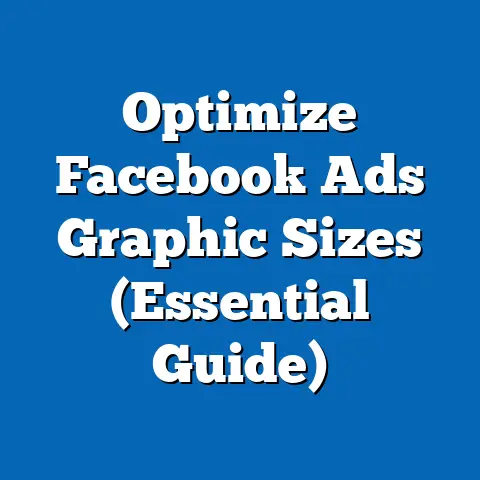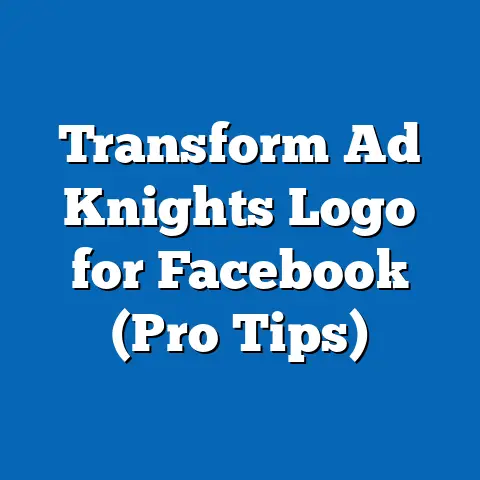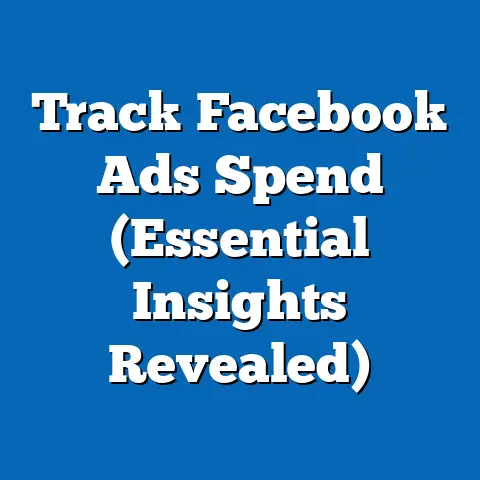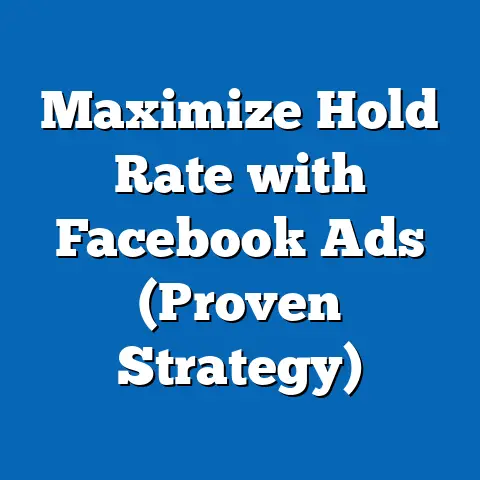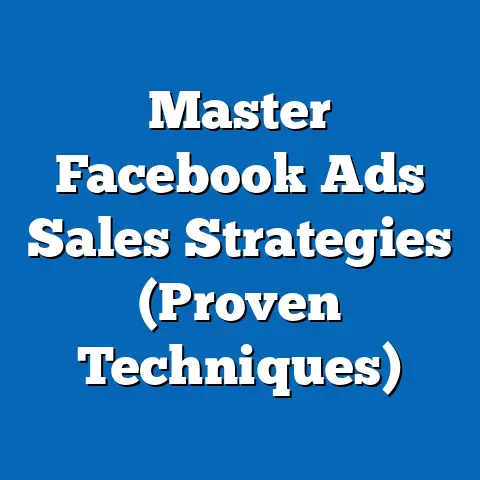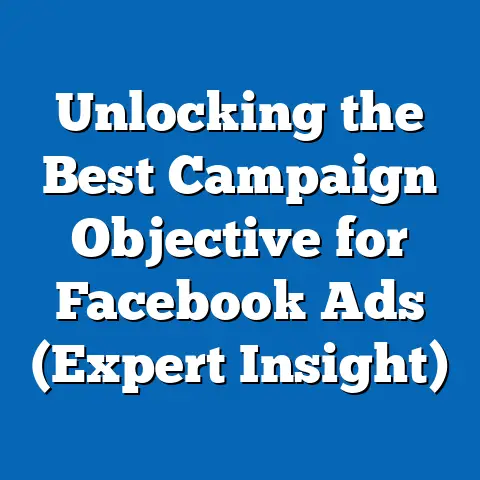Revive Facebook Conversion Ads (Pro Tips Revealed)
In today’s world, where sustainability is more than just a buzzword, businesses are increasingly recognizing the importance of eco-technology (eco-tech). As consumers become more eco-conscious, their purchasing decisions are heavily influenced by a brand’s commitment to environmental responsibility. This shift has profound implications for digital advertising, especially on platforms like Facebook.
Facebook, with its billions of active users, remains a powerhouse for conversion ads. However, in an era where consumers demand authenticity and sustainability, simply running generic ads won’t cut it. We need to optimize Facebook conversion ads to align with eco-tech values and resonate with an eco-conscious audience.
I’ve spent years crafting and analyzing Facebook ad campaigns, and I’ve seen firsthand how a strategic, eco-focused approach can dramatically improve conversion rates. It’s not just about slapping a green logo on your ad; it’s about genuinely communicating your brand’s commitment to sustainability and offering products or services that align with your audience’s values.
1. Understanding Facebook Conversion Ads
Facebook conversion ads are designed to encourage specific actions on your website or app, such as making a purchase, signing up for a newsletter, or downloading a resource. Unlike other ad types focused on brand awareness or engagement, conversion ads are all about driving measurable results.
What are Facebook Conversion Ads?
At their core, Facebook conversion ads use compelling visuals and persuasive copy to prompt users to take a desired action. These actions are tracked using the Facebook Pixel, a small piece of code that you install on your website. The Pixel allows Facebook to monitor user behavior, attribute conversions to your ads, and optimize your campaigns for maximum ROI.
Conversion Ads vs. Other Ad Types
It’s crucial to understand the difference between conversion ads and other types of Facebook ads. Here’s a quick breakdown:
- Awareness Ads: Focus on reaching a broad audience and increasing brand visibility. They’re great for introducing your brand to new customers but don’t typically drive immediate sales.
- Engagement Ads: Aim to generate likes, comments, shares, and other forms of interaction. They’re useful for building a community around your brand but may not directly lead to conversions.
- Traffic Ads: Designed to drive traffic to your website or landing page. While they can increase website visitors, they don’t necessarily guarantee conversions.
- Conversion Ads: Specifically optimized to encourage users to take a desired action, such as making a purchase or filling out a form. They’re the most direct route to achieving your business goals.
Setting Clear Conversion Goals
Before launching any Facebook conversion ad campaign, it’s essential to define your goals clearly. What specific action do you want users to take? Common conversion goals include:
- Purchases: Driving sales of your eco-tech products or services.
- Lead Generation: Collecting contact information from potential customers.
- Sign-Ups: Encouraging users to subscribe to your newsletter or create an account.
- Downloads: Promoting the download of your app, e-book, or other resources.
- Website Visits: Driving traffic to specific pages on your website.
Once you’ve defined your goals, you can tailor your ad content, targeting, and bidding strategy to maximize conversions.
The Effectiveness of Facebook Conversion Ads
Facebook conversion ads can be incredibly effective when implemented correctly. According to recent statistics, businesses that use Facebook ads see an average return on ad spend (ROAS) of $8.71 for every $1 spent. This demonstrates the potential for significant ROI when running targeted conversion campaigns.
Furthermore, a study by HubSpot found that Facebook ads have a higher conversion rate than other social media platforms, with an average conversion rate of 9.21%. This makes Facebook an ideal platform for eco-tech businesses looking to drive sales, generate leads, and achieve other conversion-related goals.
Key Takeaway: Facebook conversion ads are a powerful tool for driving specific actions on your website or app. By setting clear goals, understanding the difference between conversion ads and other ad types, and tracking your results, you can maximize the effectiveness of your campaigns. Next, we’ll explore how eco-tech companies are leveraging these ads to reach their target audience.
2. The Eco-Tech Connection
Eco-tech companies are uniquely positioned to benefit from Facebook conversion ads. By aligning their marketing efforts with their core values of sustainability and environmental responsibility, they can attract a highly engaged and loyal customer base.
How Eco-Tech Companies Leverage Facebook Ads
Eco-tech businesses are using Facebook conversion ads in various creative ways to reach their target audience. Some common strategies include:
- Highlighting Sustainable Practices: Ads that showcase a company’s commitment to sustainability, such as using recycled materials, reducing carbon emissions, or supporting environmental initiatives, can resonate with eco-conscious consumers.
- Promoting Eco-Friendly Products: Ads that feature innovative eco-tech products, such as solar-powered chargers, energy-efficient appliances, or sustainable packaging solutions, can attract customers looking for environmentally friendly alternatives.
- Educating Consumers: Ads that provide educational content about environmental issues and the benefits of eco-tech solutions can raise awareness and drive demand for sustainable products and services.
- Offering Exclusive Discounts: Ads that offer exclusive discounts or promotions to eco-conscious consumers can incentivize purchases and build brand loyalty.
Case Studies of Successful Eco-Tech Brands
Let’s look at some real-world examples of eco-tech brands that have successfully used Facebook conversion ads:
- Patagonia: Known for its commitment to environmental activism, Patagonia has run Facebook ads that highlight its sustainable manufacturing practices and encourage customers to repair and recycle their products. These ads not only drive sales but also reinforce the brand’s values.
- Allbirds: This footwear company uses Facebook ads to showcase its sustainable materials, such as merino wool and eucalyptus tree fiber. Their ads often feature customer testimonials and highlight the comfort and durability of their shoes.
- Tesla: As a leader in electric vehicles, Tesla uses Facebook ads to promote its cars and energy products. Their ads often focus on the environmental benefits of electric vehicles and the cost savings of using solar energy.
Aligning Values with Consumer Preferences
The success of these brands lies in their ability to align their values with consumer preferences. Eco-conscious consumers are not just looking for products that are environmentally friendly; they’re also looking for brands that share their values and are committed to making a positive impact on the world.
By authentically communicating their commitment to sustainability in their Facebook ads, eco-tech businesses can build trust and credibility with their target audience, leading to higher conversion rates and long-term customer loyalty.
The Potential for High Conversion Rates
Eco-tech products often have a higher perceived value among eco-conscious consumers, which can translate into higher conversion rates. When consumers believe that a product is not only high-quality but also environmentally responsible, they’re more likely to make a purchase.
Additionally, eco-tech products often address specific pain points for consumers, such as reducing energy consumption, minimizing waste, or improving air quality. By highlighting these benefits in their Facebook ads, eco-tech businesses can attract customers who are actively seeking solutions to their environmental concerns.
Key Takeaway: Eco-tech companies can leverage Facebook conversion ads to reach a highly engaged and loyal customer base. By aligning their marketing efforts with their core values of sustainability and environmental responsibility, they can attract customers who are looking for products and brands that share their commitment to making a positive impact on the world. Next up, we’ll discuss how to craft compelling ad content that resonates with eco-conscious consumers.
3. Crafting Compelling Ad Content
Creating compelling ad content is crucial for driving conversions on Facebook. Your ad copy and visuals must capture your audience’s attention, communicate your value proposition, and persuade them to take action. This is especially important for eco-tech businesses, where authenticity and transparency are key.
Elements of Effective Ad Copy
Effective ad copy is clear, concise, and persuasive. It should include a compelling headline, a concise description, and a strong call-to-action (CTA). Here’s a breakdown of each element:
- Headline: The headline is the first thing users see, so it must be attention-grabbing and relevant to your target audience. Use strong verbs, numbers, and keywords to make your headline stand out. For eco-tech businesses, you might highlight the environmental benefits of your product or service in the headline.
- Example: “Save Money and the Planet with Our Solar-Powered Charger”
- Description: The description provides more detail about your product or service and its benefits. Focus on solving your audience’s pain points and highlighting the unique value proposition of your eco-tech solution.
- Example: “Our solar-powered charger is made from recycled materials and can fully charge your phone in just 2 hours. Perfect for outdoor adventures and reducing your carbon footprint.”
- Call-to-Action: The CTA tells users what you want them to do next. Use action-oriented language and create a sense of urgency to encourage clicks.
- Example: “Shop Now and Get 20% Off Your First Order”
- Example: “Save Money and the Planet with Our Solar-Powered Charger”
- Example: “Our solar-powered charger is made from recycled materials and can fully charge your phone in just 2 hours. Perfect for outdoor adventures and reducing your carbon footprint.”
- Example: “Shop Now and Get 20% Off Your First Order”
The Importance of Visuals
Visuals play a critical role in Facebook conversion ads, especially for eco-tech products. High-quality images and videos can showcase the beauty and functionality of your products, while also communicating your brand’s commitment to sustainability.
When choosing visuals, consider the following:
- Authenticity: Use real photos and videos of your products in action. Avoid stock images that look generic or staged.
- Environmental Context: Show your products in natural settings or highlight their environmental benefits. For example, you might show a solar panel on a rooftop or a reusable water bottle in a scenic hiking spot.
- Customer Testimonials: Include visuals of satisfied customers using your products. This can build trust and credibility with potential buyers.
- Brand Consistency: Ensure your visuals align with your brand’s overall aesthetic and messaging.
Conveying Sustainability Messaging Authentically
Consumers are increasingly skeptical of greenwashing, so it’s crucial to convey your sustainability messaging authentically. Avoid making exaggerated claims or using vague language. Instead, focus on providing specific details about your environmental initiatives and the impact of your products.
Here are some tips for conveying sustainability messaging authentically:
- Transparency: Be open and honest about your environmental practices, even if they’re not perfect.
- Certifications: Highlight any certifications you have, such as Fair Trade, LEED, or B Corp.
- Impact Data: Share data on the environmental impact of your products, such as carbon emissions saved or waste reduced.
- Storytelling: Tell stories about your brand’s commitment to sustainability and the people who are making a difference.
Examples of High-Performing Ad Content
Here are some examples of high-performing ad content from eco-tech brands:
- Company A (Sustainable Clothing): Image of a model wearing their clothing in a natural setting, headline: “Eco-Friendly Fashion That Looks and Feels Great,” description: “Our clothing is made from organic cotton and recycled materials. Shop now and support sustainable fashion,” CTA: “Shop Now”
- Company B (Reusable Water Bottles): Video of a customer using their water bottle on a hike, headline: “Stay Hydrated and Reduce Plastic Waste,” description: “Our reusable water bottles are made from stainless steel and are BPA-free. Order yours today,” CTA: “Learn More”
- Company C (Solar Panels): Image of solar panels on a rooftop, headline: “Save Money and the Environment with Solar Power,” description: “Our solar panels are highly efficient and come with a 25-year warranty. Get a free quote today,” CTA: “Get a Quote”
Key Takeaway: Crafting compelling ad content is essential for driving conversions on Facebook. By creating clear, concise, and persuasive ad copy, using high-quality visuals, and conveying your sustainability messaging authentically, you can attract eco-conscious consumers and achieve your business goals. Next, we’ll explore how to target the right audience for your Facebook conversion ads.
4. Targeting the Right Audience
Targeting the right audience is crucial for the success of your Facebook conversion ads. By reaching the people who are most likely to be interested in your eco-tech products or services, you can maximize your ROI and drive meaningful results.
The Importance of Audience Targeting
Facebook’s audience targeting capabilities are incredibly powerful. You can target users based on demographics, interests, behaviors, and more. This allows you to create highly specific audiences that are more likely to convert.
Without proper targeting, your ads may be shown to people who have no interest in eco-tech, resulting in wasted ad spend and low conversion rates. Therefore, it’s essential to invest time and effort in defining your target audience and using Facebook’s tools to reach them.
Using Facebook’s Audience Insights
Facebook’s Audience Insights tool provides valuable data about your target audience, including their demographics, interests, behaviors, and purchasing habits. This information can help you create more effective targeting strategies.
To use Audience Insights, go to Facebook Ads Manager and select “Audience Insights” from the “Tools” menu. You can then choose to analyze either “Everyone on Facebook” or “People connected to your Page.”
When analyzing “Everyone on Facebook,” you can filter by location, age, gender, interests, and more. This allows you to identify potential target audiences based on their characteristics.
When analyzing “People connected to your Page,” you can learn more about your existing fans and customers. This information can help you create lookalike audiences, which are users who share similar characteristics with your existing customers.
Creating Custom and Lookalike Audiences
Custom audiences allow you to target users who have already interacted with your business, such as website visitors, email subscribers, or app users. Lookalike audiences, on the other hand, allow you to reach new users who share similar characteristics with your existing customers.
To create a custom audience, go to Facebook Ads Manager and select “Audiences” from the “Tools” menu. You can then choose to create a custom audience based on various sources, such as:
- Website Traffic: Target users who have visited specific pages on your website.
- Customer List: Upload a list of your email subscribers or customer data.
- App Activity: Target users who have interacted with your app.
- Offline Activity: Target users who have interacted with your business offline.
To create a lookalike audience, you must first create a custom audience. You can then select “Create Lookalike Audience” and choose the size and location of your lookalike audience.
Demographic and Psychographic Factors
When targeting eco-tech consumers, it’s essential to consider both demographic and psychographic factors.
- Demographic Factors: Include age, gender, location, education, and income. Eco-conscious consumers are often younger, more educated, and have a higher income.
- Psychographic Factors: Include values, interests, lifestyle, and attitudes. Eco-conscious consumers are often passionate about environmental issues, value sustainability, and lead a healthy lifestyle.
By combining demographic and psychographic factors, you can create highly targeted audiences that are more likely to be interested in your eco-tech products or services.
Key Takeaway: Targeting the right audience is crucial for the success of your Facebook conversion ads. By using Facebook’s Audience Insights tool, creating custom and lookalike audiences, and considering both demographic and psychographic factors, you can reach the people who are most likely to convert. Next, we’ll explore how to optimize your ad performance for maximum ROI.
5. Optimizing Ad Performance
Once you’ve launched your Facebook conversion ads, it’s essential to continuously monitor and optimize their performance. By testing different ad elements, analyzing your results, and making data-driven adjustments, you can maximize your ROI and achieve your business goals.
The Importance of Testing and Optimization
Facebook’s algorithm is constantly evolving, so what worked today may not work tomorrow. Therefore, it’s essential to continuously test and optimize your ads to stay ahead of the curve.
Testing allows you to identify the ad elements that resonate most with your target audience. Optimization allows you to improve your ad performance based on your test results.
A/B Testing Strategies
A/B testing, also known as split testing, involves creating two or more versions of an ad and comparing their performance. You can test different elements, such as headlines, descriptions, visuals, CTAs, and targeting options.
To conduct an A/B test, create two versions of your ad with one variable changed. For example, you might test two different headlines or two different images. Run both ads simultaneously and track their performance. The ad with the higher conversion rate is the winner.
Here are some A/B testing strategies for eco-tech businesses:
- Headline Testing: Test different headlines that highlight the environmental benefits of your product or service.
- Visual Testing: Test different images or videos that showcase your product in action or communicate your brand’s commitment to sustainability.
- CTA Testing: Test different CTAs that encourage users to take a specific action, such as “Shop Now,” “Learn More,” or “Get a Free Quote.”
- Targeting Testing: Test different targeting options to identify the audience segments that are most likely to convert.
Understanding Facebook’s Algorithm
Facebook’s algorithm determines which ads are shown to which users. The algorithm takes into account various factors, such as ad relevance, bid amount, and estimated action rates.
To improve your ad relevance, make sure your ad content is highly relevant to your target audience. Use keywords that your audience is likely to search for and highlight the benefits of your product or service that are most important to them.
To improve your bid amount, consider using automated bidding strategies, such as cost per acquisition (CPA) bidding or value-based bidding. These strategies allow Facebook to automatically adjust your bids to maximize your ROI.
To improve your estimated action rates, focus on creating high-quality ad content that encourages users to take action. Use compelling visuals, persuasive copy, and a strong CTA.
Tactics for Optimizing Ad Spending
Optimizing your ad spending is crucial for maximizing your ROI. Here are some tactics for optimizing your ad spending:
- Set a Budget: Determine how much you’re willing to spend on your Facebook ads and stick to your budget.
- Monitor Your Results: Track your ad performance closely and identify areas for improvement.
- Adjust Your Bids: Adjust your bids based on your ad performance. If your ads are performing well, you can increase your bids to reach a larger audience. If your ads are not performing well, you can decrease your bids to save money.
- Pause Underperforming Ads: If an ad is not performing well, pause it and focus on optimizing your other ads.
- Reallocate Your Budget: Reallocate your budget to the ads that are performing best.
Key Takeaway: Optimizing your ad performance is essential for maximizing your ROI. By testing different ad elements, understanding Facebook’s algorithm, and optimizing your ad spending, you can achieve your business goals. Next, we’ll explore how to leverage Facebook’s tools and features to enhance your ad campaigns.
6. Leveraging Facebook’s Tools and Features
Facebook offers a range of tools and features that can help you enhance your ad campaigns, track your results, and optimize your strategies. By leveraging these tools effectively, you can maximize your ROI and achieve your business goals.
Exploring Facebook’s Advertising Tools
Facebook provides a comprehensive suite of advertising tools, including:
- Ads Manager: The Ads Manager is your central hub for creating, managing, and tracking your Facebook ad campaigns. It allows you to set your budget, define your target audience, create your ad content, and monitor your results.
- Facebook Pixel: The Facebook Pixel is a small piece of code that you install on your website. It allows Facebook to track user behavior, attribute conversions to your ads, and optimize your campaigns for maximum ROI.
- Audience Insights: The Audience Insights tool provides valuable data about your target audience, including their demographics, interests, behaviors, and purchasing habits.
- Creative Hub: The Creative Hub allows you to create and preview your ad content before launching your campaign. It also provides inspiration and best practices for creating effective ads.
- Facebook Analytics: Facebook Analytics provides detailed insights into your website traffic, app usage, and customer behavior. This information can help you understand how users are interacting with your business and identify areas for improvement.
Tracking Conversions and Utilizing Data
Tracking conversions is crucial for measuring the success of your Facebook ad campaigns. By tracking conversions, you can see which ads are driving the most sales, leads, or other desired actions.
To track conversions, you need to install the Facebook Pixel on your website and set up conversion tracking events. Conversion tracking events are specific actions that you want to track, such as purchases, lead form submissions, or website visits.
Once you’ve set up conversion tracking events, you can view your conversion data in the Ads Manager. This data will show you how many conversions each ad is generating and the cost per conversion.
By analyzing your conversion data, you can identify which ads are performing well and which ads need improvement. You can then use this information to optimize your ad content, targeting, and bidding strategy.
Setting Up the Facebook Pixel for Eco-Tech Businesses
Setting up the Facebook Pixel is essential for tracking conversions and optimizing your Facebook ad campaigns. Here’s a step-by-step guide on how to set up the Facebook Pixel for eco-tech businesses:
- Create a Facebook Pixel: Go to Facebook Ads Manager and select “Pixels” from the “Tools” menu. Click “Create Pixel” and follow the instructions.
- Install the Pixel Code: Once you’ve created your Pixel, you’ll need to install the Pixel code on your website. You can either manually add the code to your website’s header or use a plugin or integration to install it automatically.
- Set Up Conversion Events: After you’ve installed the Pixel code, you’ll need to set up conversion events. Go to Facebook Ads Manager and select “Custom Conversions” from the “Tools” menu. Click “Create Custom Conversion” and follow the instructions.
- Test Your Pixel: Once you’ve set up your conversion events, test your Pixel to make sure it’s tracking conversions correctly. You can use the Facebook Pixel Helper Chrome extension to verify that your Pixel is firing properly.
Advanced Features: Dynamic Ads and Retargeting
Facebook offers several advanced features that can help you enhance your ad campaigns, including dynamic ads and retargeting.
- Dynamic Ads: Dynamic ads allow you to automatically show users products that they’ve viewed on your website. This can be a highly effective way to re-engage potential customers and drive sales.
- Retargeting: Retargeting allows you to show ads to users who have previously interacted with your business, such as website visitors, email subscribers, or app users. This can be a great way to remind users about your products or services and encourage them to take action.
Key Takeaway: Facebook offers a range of tools and features that can help you enhance your ad campaigns, track your results, and optimize your strategies. By leveraging these tools effectively, you can maximize your ROI and achieve your business goals. Finally, let’s discuss how to stay ahead of emerging trends in Facebook advertising and the eco-tech industry.
7. Staying Ahead of Trends
The digital advertising landscape is constantly evolving, so it’s essential to stay ahead of emerging trends to maintain a competitive edge. This is especially important for eco-tech businesses, where consumer preferences and regulations are constantly changing.
Emerging Trends in Facebook Advertising
Here are some emerging trends in Facebook advertising that eco-tech businesses should be aware of:
- Video Marketing: Video is becoming increasingly popular on Facebook, so it’s essential to incorporate video into your ad campaigns.
- Mobile Optimization: More and more users are accessing Facebook on their mobile devices, so it’s essential to optimize your ads for mobile.
- Personalization: Consumers are demanding more personalized experiences, so it’s essential to personalize your ads based on user data.
- Augmented Reality (AR): AR is becoming increasingly popular on Facebook, so it’s essential to explore opportunities to use AR in your ad campaigns.
- Social Commerce: Social commerce is on the rise, so it’s essential to make it easy for users to purchase your products directly from Facebook.
The Impact of Regulations and Shifting Consumer Behaviors
Regulations and consumer behaviors are constantly shifting towards sustainability, so it’s essential to stay informed and adapt your strategies accordingly.
Governments around the world are implementing new regulations to promote sustainability, such as carbon taxes, plastic bans, and renewable energy mandates. These regulations can impact the demand for eco-tech products and services.
Consumers are also becoming more eco-conscious and are demanding more sustainable products and services. This is driving demand for eco-tech solutions and creating new opportunities for businesses in the sector.
Future Developments in Facebook Advertising and Eco-Tech
Here are some potential future developments in Facebook advertising and the eco-tech industry:
- AI-Powered Advertising: AI is likely to play an increasingly important role in Facebook advertising, helping businesses to optimize their campaigns and personalize their ads.
- Blockchain Technology: Blockchain technology could be used to track the supply chain of eco-tech products, providing consumers with more transparency and trust.
- Virtual Reality (VR): VR could be used to create immersive experiences that showcase the benefits of eco-tech products and services.
- Sustainable Advertising: Facebook may introduce new features to promote sustainable advertising, such as carbon-neutral ad campaigns or eco-friendly ad formats.
Key Takeaway: Staying ahead of emerging trends is essential for maintaining a competitive edge in the digital advertising landscape. By being aware of the latest trends, adapting to shifting regulations and consumer behaviors, and exploring future developments in Facebook advertising and the eco-tech industry, you can position your business for long-term success.
Conclusion
In conclusion, revamping your Facebook conversion ads with a focus on eco-tech values is not just a trend; it’s a necessity for businesses looking to thrive in today’s market. By understanding the fundamentals of conversion ads, aligning your values with consumer preferences, crafting compelling ad content, targeting the right audience, optimizing your ad performance, leveraging Facebook’s tools and features, and staying ahead of emerging trends, you can create impactful campaigns that drive results while staying true to your eco-friendly mission.
Remember, authenticity and transparency are key. Consumers are increasingly skeptical of greenwashing, so it’s crucial to communicate your brand’s commitment to sustainability authentically. By sharing specific details about your environmental initiatives, highlighting your certifications, and telling stories about your brand’s impact, you can build trust and credibility with your target audience.
The digital advertising landscape is constantly evolving, so it’s essential to continuously monitor your results, test new strategies, and adapt to changing consumer behaviors. By staying informed and proactive, you can maximize your ROI and achieve your business goals.
Call to Action
Ready to take your Facebook conversion ads to the next level? Implement the pro tips shared in this article and stay engaged with the latest trends in eco-tech and digital advertising. By continuously evolving your strategies and staying true to your values, you can create impactful campaigns that drive results and make a positive impact on the world.
Now, go out there and create some amazing eco-tech Facebook conversion ads! I’m excited to see the positive impact you’ll make.

